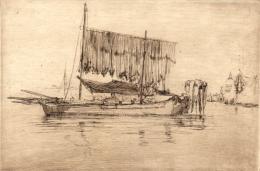July 28, 2013 - October 20, 2013
In 1879 American artist James McNeill Whistler arrived in Italy with a commission from the Fine Arts Society of London to create twelve etchings of Venice. Over the ensuing fourteen months the artist produced a body of prints that are among the most important of his career. The prints from Whistler’s Venice period are distinguished by the artist’s original approach to capturing the unique qualities of the canaled city and his innovative use of the etching process. His prints have arguably become the most studied prints in the history of art– after those of Rembrandt – and they had a significant influence on his followers.
This exhibit presents eleven prints by Whistler, placing them alongside the work of followers who were practicing in Italy in the late-nineteenth and early-twentieth centuries. The juxtaposition of these works allows the viewer to appreciate both Whistler’s innovations and the different ways in which his work affected the artists who followed him. While artists such as John Marin are well known today, and Mortimer Menpes and Joseph Pennell still enjoy a modicum of fame, other artists in this exhibit, like Minna Bolingbroke, have faded. Whistler’s legacy lies in his far-reaching vision for both his medium and his subject, which has made his art significant for a remarkably broad range of colleagues.
The exhibition is organized by the Syracuse University Art Gallery
The Arkell Museum owns a painting by Whistler that will be included in this exhibition.
This exhibition is funded in part by the New York State Council on the Arts, a State Agency, Fenimore Asset Management, and the Montgomery County Occupancy Tax administered by the Montgomery County Board of Supervisors.






